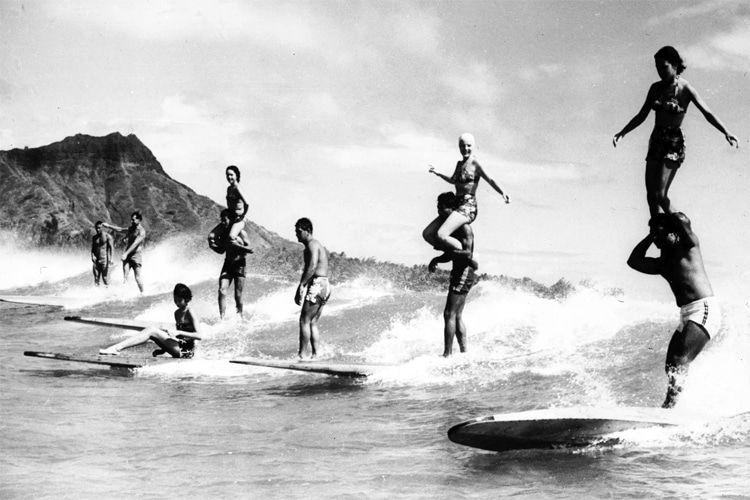Polynesians were among the first on planet Earth to explore the art of surfing and board riding across all sorts of water bodies.
The Hawaiians, in particular, are known to have developed and practiced six different traditional surf-related sports:
- He'e nalu, or board surfing;
- Pākākā nalu, or outrigger canoe surfing;
- Kaha nalu, or bodysurfing;
- Pae po'o, or bodyboarding;
- He'e one, or sand sliding;
- He'e pu'e wai, or river surfing;
Let's take a look at each of them, as identified by John R. K. Clark's "Hawaiian Surfing" book.
He'e Nalu: Board Surfing
Among all the Hawaiian sports, none have ensnared the fascination of non-Hawaiians quite like the art of surfing.
Patrick Moser, in his compilation "Pacific Passages," gathers the initial European observations of this sport in Hawaii, succinctly summarizing the various reactions.
These included feelings of dread and shock, as well as astonishment and admiration, all intertwined in the Western world's inaugural descriptions of surfriding.
In the year 1778, Captain James Cook made his way to Hawai'i. After departing, he later returned to the Big Island of Hawaii in 1779.
It was then that he and his crew became the first Westerners to observe and chronicle traditional Hawaiian surfing. They stumbled upon surfers at Kealakekua Bay, meticulously documenting the breathtaking display.
Within the Hawaiian surfing community, at least four distinct varieties of papa he'e nalu or surfboards were employed:
- Papa olo: These were narrow, dense, heavy boards with a rounded top and bottom, measuring between fourteen and sixteen feet in length;
- Papa kiko'o: Resembling an olo, but less bulky. They were flat on the deck, rounded at the bottom, spanning from nine to sixteen feet;
- Papa alaia: These were the most prevalent boards and were noticeably slimmer, lighter, shorter, and wider, falling in the range of six to nine feet;
- Papa li'ili'i: The most diminutive of the boards, these were less than six feet in length.
As the 1900s rolled in, Hawaiian surfers in Waikiki began to refer to papa li'ili'i as pae po'o or pae pō boards. This nomenclature gradually evolved into the now widely used term paipo boards.
Pakaka Nalu: Outrigger Canoe Surfing

Waikiki stands unique across the globe, being the only locale where outrigger canoes are ridden on the surf every single day, upholding a practice that has thrived for centuries.
In "The Hawaiian Canoe," an authored work by Tommy Holmes, it's noted that surfing with canoes was a custom "distinct to and cherished by ancient Hawaiians," a sentiment that resonates even now.
The endurance of this sport is primarily attributed to the beachboys of Waikiki, who make available commercial rides on these canoes.
For those who haven't surfed, engaging in this activity provides an exciting gateway to experience the adrenaline of riding a wave without the necessity of mounting a surfboard.
A prominent highlight of the Outrigger Canoe Club's yearly Fourth of July canoe races in Waikiki is the inclusion of canoe surfing.
This race, known as the Walter J. Macfarlane Memorial Canoe Regatta, is initiated on the beach in front of the Moana Hotel, leads around an offshore buoy, and returns through the waves at a surfing area recognized as Canoes.
The act of navigating a surf-bound canoe amidst a race demands exceptional control, infusing an added complexity to every competition.
Even the most robust paddlers may be defeated by those possessing superior canoe surfing finesse.
In the native tongue, Hawaiians referred to this form of surfing as pākākā nalu or pākākā wa'a, practicing it across the various islands.
Canoes, owing to their greater length and heaviness, are better adapted to leisurely breaking waves with smooth, rolling shoulders as opposed to abrupt, swift, and hollow-breaking waves.
In Waikiki, the surf location named Canoes, historically referred to as Kapuni by Hawaiians, is an idyllic site for canoe surfing.
Traditionally, canoe surfers have utilized the western side of this break, a tradition that continues to this day.
Kaha Nalu: Bodysurfing
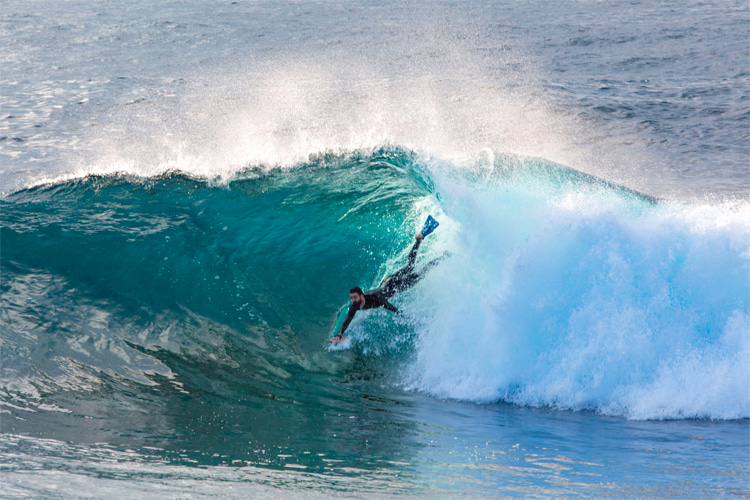
Bodysurfing, known as kaha nalu in Hawaiian, enjoyed as much popularity among Hawaiians as did surfing, though it never attained the same level of recognition from Western writers.
The grand spectacle of surfing often eclipsed bodysurfing, leading it to be perceived as merely frolicking and swimming amid the waves.
However, for the native Hawaiians, this was a fundamental, daily surf sport, requiring nothing more than the skills to swim and seize a wave.
One of the earliest known references to bodysurfing appears in "The Epic Tale of Hi'iakaikapoliopele." In this tale, the goddess Hi'iaka and her sibling, Kānemilohae, engage in surfing with the Kauai chieftain, Lohi'au, in a mystical endeavor to restore him to life permanently.
Under Hi'iaka's guidance, she and Lohi'au venture far into the ocean, where she miraculously transforms her pā'u, or sarong, into a surfboard for his use.
Together, they harness an enormous wave, with Lohi'au riding the board and Hi'iaka bodysurfing. As they glide on the wave, Kānemilohae joins them, skillfully surfing on a seashell board.
This mythical illustration of bodysurfing legitimizes the sport as an early Hawaiian wave-riding activity, portraying it as an endeavor not only practiced but also endorsed by divine beings.
Pae Po'o: Bodyboarding
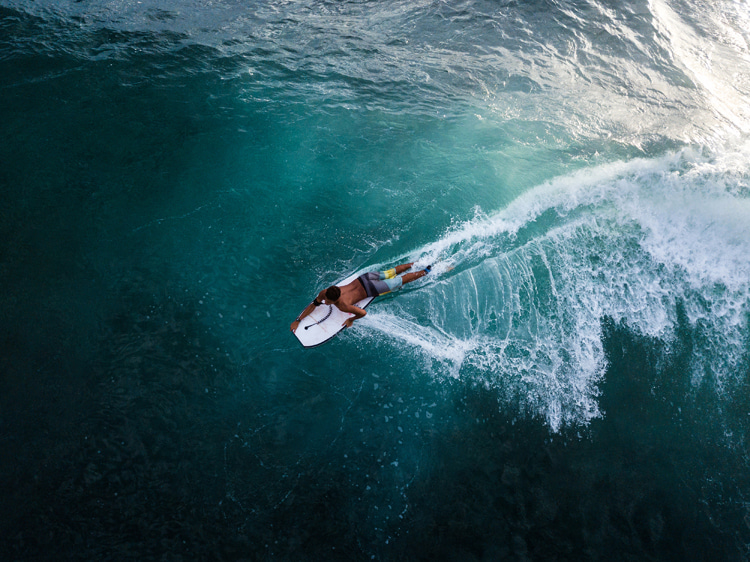
In the first records made by Hawaiian scholars about surfboards, the smallest ones, those less than six feet long, were broadly referred to as papa li'ili'i, or "small boards."
In the early part of the 1900s, the term papa li'ili'i was supplanted by two other names, one in English and the other in Hawaiian.
Those who were not Hawaiian referred to them as bellyboards, as they were predominantly ridden in a prone position, with the surfer lying on their stomach, while Hawaiian surfers in Waikiki dubbed them pae po'o boards.
The term pae po'o is intriguing.
It is absent from any Hawaiian dictionaries, Hawaiian-language newspapers, or the writings of distinguished Hawaiian scholars from the 1800s who detailed traditional Hawaiian surfing sports.
This expression was invented by Hawaiian surfers in Waikiki, where it was typically used to signify either bodysurfing or bodysurfing using a compact wooden bodyboard.
Pae po'o translates literally to "to ride [a wave] head-first," or, put another way, "to bodysurf," and a papa pae poo would be a board designed for bodysurfing, what contemporary surfers refer to as a bodyboard.
In casual speech, the Hawaiian phrase pae po'o was frequently abbreviated to pae pō.
In English, it is usual to modify the pronunciation of Hawaiian words ending with double "o's," as in the place name Nāpo'opo'o on the island of Hawaii, commonly pronounced Nāpōpō.
The now-prevalent spelling, paipo, was introduced by Hawaiian surfing icon Wally Froiseth, who was not only a brilliant surfer but also a remarkable paipo rider, celebrated for standing atop his twin-fin paipo board on large waves.
Between 1956 and 1986, Froiseth crafted roughly one hundred paipo boards, distributing them to friends or selling them to fellow surfers.
He attached a decal to each board that stated, "Hawaiian Pai Po Board. Mfg. by Froiseth."
Before Froiseth, no one had ever penned pae pō, so without any written reference, he spelled it phonetically as he perceived it: pai po.
Froiseth's sales to California surfers played a role in popularizing the term beyond Hawai'i's shores.
He'e One: Sand Sliding
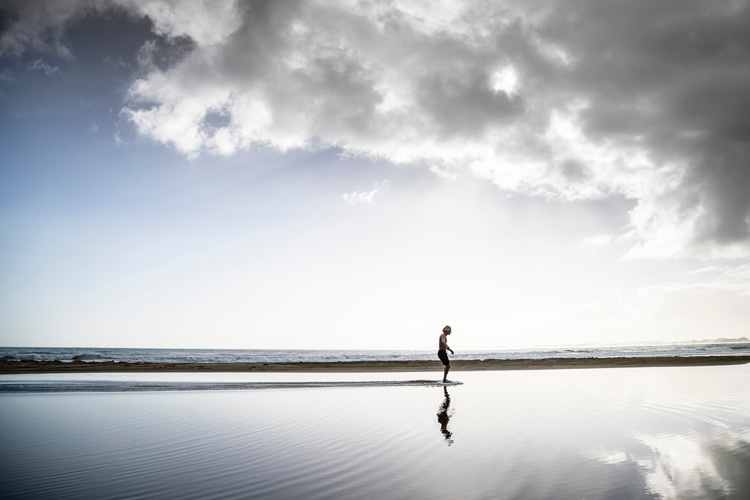
The affection Hawaiians held for surfing extended beyond merely riding waves toward the shore; it also encompassed riding waves from the shore back into the ocean.
This sport is universally known as he'e one, translating to "sand surfing," or in English, it's referred to as sand sliding, skimboarding, or simply skimming.
The primitive form of sand sliding involved riding the backwash using only one's body.
On precipitous beaches where waves reach the top of the foreshore, Hawaiians would await a receding wave, pursue it, then execute a flat dive onto their torsos, clamp their arms to their flanks, and glide the ebbing water back into the shore break.
In the initial years of the 1900s, Hawaiian surfers in Waikiki devised various twists to the classic sand-sliding concept, utilizing paipo boards and inflated pillowcases or mattress covers to skim over the beach rather than just their bodies.
In 2007, Scott Sorensen, the proprietor of Coco Palm Pictures, a firm specializing in video production, reviewed all the early surfing clips from Hawaii stored at the National Archives in Maryland and stumbled upon an astonishing 1930s clip of three Hawaiians on Waikiki Beach sand sliding on the same wave - one on his chest, another on a paipo board, and a third on a pillowcase.
This singular discovery was showcased in "Hawaiian Skies to Hawai'i" in 2008, a video Sorensen created for the in-flight entertainment of Hawaiian Airlines.
Sand sliding on a paipo board begins with chasing a retreating wave, board in hand, placing it on the thin film of water left behind by the wave, then leaping onto the board and riding it upright into the shore break.
In 1935, Tom Blake detailed a variation of this sport that he named a "Running Start From Shore," where surfers would skim across a beach on their surfboards, employing the sand sliding technique.
At this juncture in time, surfboards were not equipped with fins, allowing for skimming on the traditional wooden boards of the era.
He'e Pu'e Wai. River Surfing
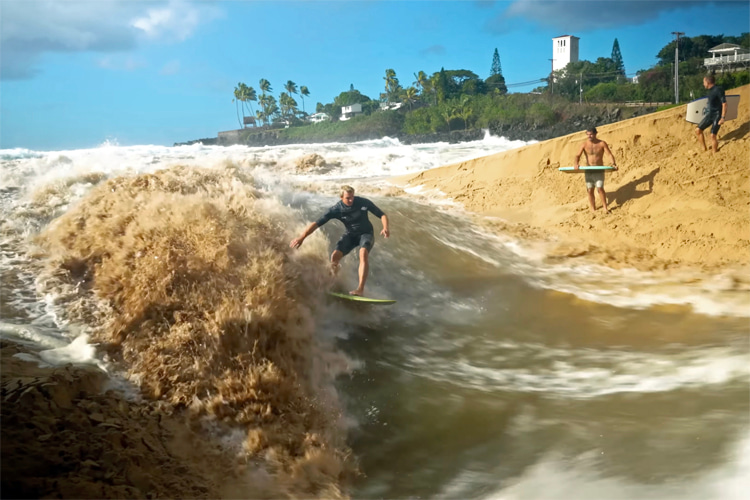
Hawaiians had a passion for surfing and would ride virtually any wave available to them, even those created by an unexpected source: flash-flooding rivers.
Persistent heavy rainfall in Hawaii's mountains can lead to flash floods, unleashing enormous quantities of water down the rivers towards the sea.
Under the right circumstances, the substantial amount of water pouring into the ocean can form stationary or standing waves.
The Hawaiians took advantage of these waves, surfing those that appeared in rivers or where rivers met the sea.
They named this unique form of surfing he'e pu'e wai, which translates to "surfing agitated water," with the floodwaters in a river or stream being the "agitated water" in question.
Various expressions were used in their writings to describe this sport, including "wai he'e pu'e," "he'e nalu o ka pu'e," and "he'e i ka pu'e wai."
Present-day surfers across the globe refer to this as river surfing.
Hawaiians practiced river surfing in various locations across at least four islands, including the Wailua River on Kauai, the Waimea River on Oahu, the Wailuku and Waiohonu rivers on Maui, and the Wailuku, Honoli'i, Papa'ikou, and Waipi'o rivers on the island of Hawaii.
They would ride two distinct types of stationary waves: those that arose within a river, such as in the Wailuku River on the island of Hawaii, and those that appeared where a river cut through a sandy beach that ordinarily obstructed the river, like the Waimea River.
Beyond surfing stationary waves, they also embraced the river itself, diving in upstream with their boards and allowing the surging water to carry them to the ocean.
In the later 1800s and early 1900s, the creation of irrigation ditches and other water management structures decreased the flow in many of Hawaii's rivers, affecting, among other things, their ability to form surfable stationary waves.
Alongside these modifications and the overall waning of surfing as a widespread hobby, he'e pu'e wai vanished from all its prior locations except for Waimea Bay.
There, the Waimea River continues to wear down the beach that obstructs it, forming surfable stationary waves when its swollen waters reach the sea.
For rivers obstructed by beaches, like Waimea, a constant large flow of water is required to naturally breach the sandbank, though, at times, the river can be deliberately directed to flow by excavating a channel through the sand.
Once the pent-up water begins coursing through this channel, it gains momentum, generating stationary waves with profound troughs between them as it joins the ocean.
